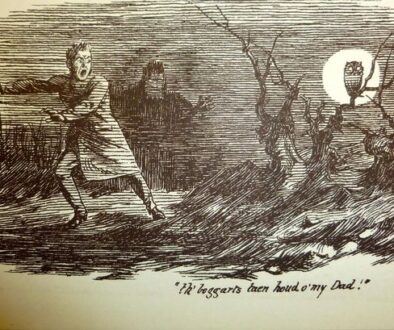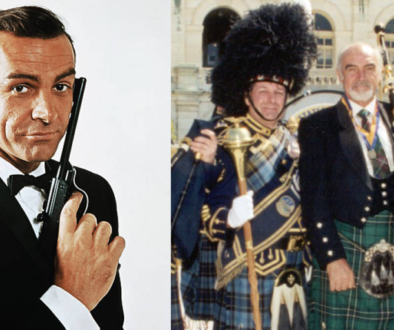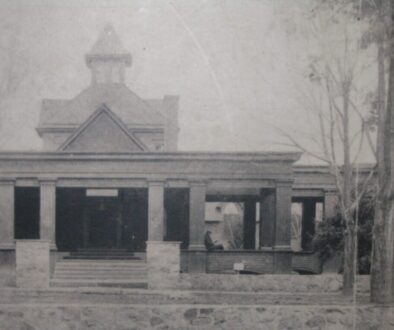The Damning of Goodleberg, Part 2: Dogs in Black and Ladies in White
Yes, it’s that time of year again. The summer months are on us and here come the ghost-hunters. It’s sure to get hot at the top of that hill holding the most prominent outdoor haunt on the Niagara Frontier and surely one of the most notorious, devastated, scandalous burying-grounds in New York State. Hold onto your hats, it’s Goodleberg…! AIEEEEEEEEE!!!!!
Goodleberg is a small outdoor space that is fairly open to the elements. It lacks the grandeur or the visual intrigue typical of most famous haunts, yet its reputation is both prodigious and by now national. The earlier article in this series was a speculation on the causes and contrasts in Goodleberg’s supernatural impact. This second piece will discuss the categories of apparitions – ghosts – and other phenomena reported at Goodleberg.
When you hear as many ghost reports as I do in a typical year, you rapidly begin to sense categories among the reported apparitions. I wish I’d been more organized from the beginning of my professional study, going back over twenty-five years. I could have quite a profile to demonstrate for you by now. Still, I have a rough feel for general types among the reports I hear about my native upstate New York, including at the fabled cemetery Goodleberg in the Town of Wales. The panorama of reports coming from the collective record of the Goodleberg experiencers seems to fall into three categories.
Some of Goodleberg’s apparitions are what almost anyone means who claims to have seen – with the naked eyes – a “ghost.” Witnesses often have an almost minute recall of certain features of these apparitions. These forms could represent the recreations of actual scenes that took place in earlier decades, right where they appear to witnesses. They could even be traceable to once-living individuals specific to the area and its historic past, though one would usually need a lot more information than is ever likely to be available to confirm a thing like that. In this category, I have heard of several examples at Goodleberg:
– The old farmer walking up Goodleberg Road by the cemetery.
– The daylight apparition of a country doctor with his bag reported on Goodleberg Road.
– The “Woman in Black” reported on nearby stretches of Hunter’s Creek and Vermont Hill roads and in several places along Route 16. This could be traceable to a historic person, Helen Lindeman, the murdered kidnap victim from Kenmore whose body parts began turning up in the general area. At the time when Mrs. Lindeman was missing but alive, there was at least one eyewitness report to a woman of this description, and an old rumor of a similar figure along Route 16/Olean Road.
Others among Goodleberg’s ghostly forms – Women in White (what the folklorists call “White Ladies”) and Little Girl Ghosts – are recycled endlessly about the upstate, which makes me think of those at Goodleberg as generic. The Woman in White of the graveyard and field beyond is the classic image of the grieving mother or widow. The Little Girl Ghost of the graveyard itself is the very embodiment of the waifish lost soul. Archetypes – image-forms with unconscious, even Jungian, significance – these forms are already resident within the human imagination and lurk at the eye-corners, ever ready to be evoked by faint visual phenomena like shadows, mist, and moonlight. Goodleberg’s little girl and white lady could of course as well as any other ghost be the forms of specific individuals in the past of the site, but this leaves us with the problem of explaining why, among all humanity’s stages and guises, little girls and adult women come back so often as ghosts.
A third category of apparition-forms represents images that are so drastically altered from forms that might once have been natural they seem not even typical for ghosts, seeming instead images of things that were never alive in any other climate than that of folklore. Images like these are common in certain outdoor spaces I often call “paranormal zones,” but they are fairly rare at American haunted sites. The ones at Goodleberg include:
– Remarkably small child-ghosts
– Remarkably big, dark, often glowing-eyed hounds.
Both are suggestive of wider themes in world legend. The ever-thinning margin between classic folklore and contemporary paranormal report has always fascinated me, and it is delightful to be able to note connections at Goodleberg.
The “Hell Hounds” up here – I take credit for naming them so in my 1997 book “Shadows” – are among the most frequently reported apparitions at Goodleberg. (Whether people really experience them or whether, inspired by the folklore, they visit Goodleberg simply hoping to see them is another question. Let’s be real; any big dog barking or baying in the distance on an inspiring night could certainly fire the imagination.)
I have met eyewitnesses who claim to have had close encounters with these large, distorted canine bogies at Goodleberg, even some who reported running over them – or something – with cars. The stricken creatures were probably never material, since no carcasses were found anywhere near. The shuddering clunk of the collision was no less vivid in more than one memory.
For all their commonness in Northern Europe, particularly in graveyards, these Black Dog-apparitions are strange rangers in the U.S. In Europe’s folklore they have multiple associations. When they appear as single apparitions, they are sometimes thought to be either the ominous protectors of burying-grounds or alternate forms for the Devil. In packs they are possibly the Hell-hounds, servants of either Heaven or Hell whose job it is to round up the souls of sinners and drive them to their fated afterlife. Yelping in the distance or echoing overhead to the night sky, they are even associated with “the Wild Hunt,” a European mythological event of indeterminate origin and profound significance. (I started an article about the Wild Hunt years ago and couldn’t summarize it to my satisfaction in 2000 words.)
I’ve written many an article about the Little People, a.k.a., “the Fairies,” surfacing in contemporary apparition-reports. I’d never have thought of looking for Little People Apparitions (LPA’s) with Goodleberg had I not asked as many detailed questions as I have. I was recently shocked to realize how many of my Goodleberg eyewitnesses had been describing ghosts of children, but ones who were supernaturally small. (For instance, one witness described a boy who looked five playing peek-a-boo from behind a gravestone. Almost none of the stones standing at Goodleberg are big enough for a boy of that age to hide behind, and it was only when I brought that up that the surreally-small size of the form became apparent to her.)
Well, this fits, too. The folkloric Little People not only have a childlike playfulness about them, but they have some murky connection to the human dead. They also have a special affinity for human children, not always to the good.
Why would witnesses report seeing ghosts at Goodleberg and only under questioning mention the startlingly small stature of the images? Why wouldn’t the size be the first thing a witness mentioned in describing one of these Little People Apparitions? I suppose it could be that some people are so shocked to be experiencing any kind of apparition that the LPA event’s first distinguishing feature seems to be that it is supernatural. In reflection, I guess it figures. Every day around us we see many small things; we see very few supernatural ones.
Goodleberg also features sightings of inanimate things, specifically luminous orbs and mystery-lights (ALP, “anomalous light phenomena”) common of haunted sites worldwide. Photographic effects like orbs and “ectoplasm” (an old term recently adapted to be used for misty effects that sometimes resolve themselves into suggestive shapes) are extremely common at Goodleberg. These are distinct from apparitions, because they never appear to the naked eye and turn up only in photography.
Others among Goodleberg’s manifestations are simple sounds and physical impressions – distant baby-cries, tiny handprints on car windows – which are all evocations of the theme of blighted reproduction supplied to us by the site’s human history of young children taken by ailments or abortions. It puts me in mind of Shakespeare’s “Scottish play,” in which the imagery of birth and fertility – or the reverse – come up so often in the speeches of MacBeth.
You don’t get this pattern at all legendary sites in Western New York. In fact, this full-house backfield of psychic images is characteristic of few sites I can recall anywhere. Even ancient power-sites like Stonehenge or the earthworks at Newark, OH, don’t get this folkloric panoply of human ghosts. Goodleberg has to have some kind of power. If nothing else, it’s over the human imagination.
The article to come will profile what I know of the mysterious Dr. Speaker and his connection to a series of murder-kidnappings.




